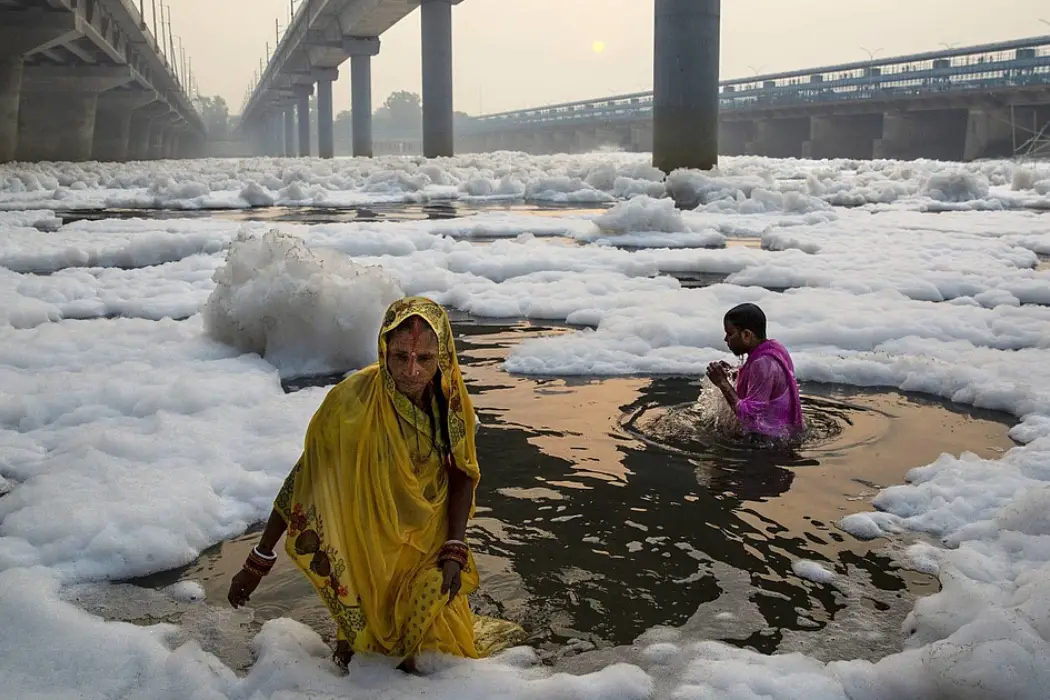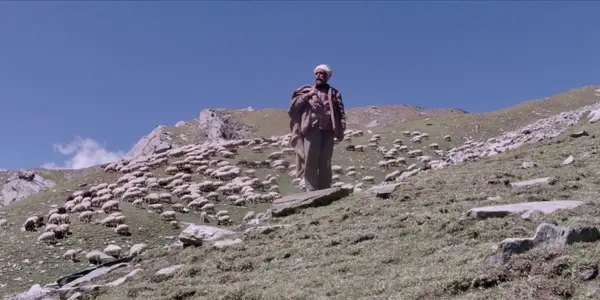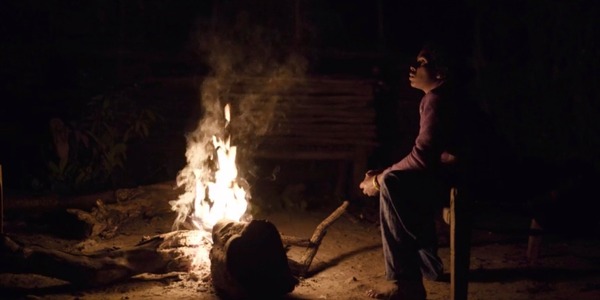MUBI’s New Indian Cinema Series: Modern Tragedies Of Nature And People

Soham Gadre is a writer/filmmaker in the Washington D.C. area.…
Much of what populates the frames of MUBI’s New Indian Cinema series selections is an obscuring of the natural world in India. Be it through buildings, clouds, dust, smog, or lighting, these frames express a severance of connection between the land that comprises India and the humans that occupy it. Perhaps this severance is the ultimate concern of modern Indian cinema or “New Indian Cinema”. In an era of hyper-nationalism in the country, it is ironic how detached and abusive the attitude of the nation has been to the physical land it occupies. Though it’s not really an established movement more a vague confluence of independent-driven artistic expressions, the three selections by MUBI under their “New Indian Cinema” series seek to explore what ails the nation, and what fears have befallen its populace.
The Gold-Laden Sheep and the Sacred Mountain (Ridham Jhanve)

Mixing mysticism and slow-burn suspense like a lot of recent North Indian independent cinema of late (see both The Shepherdess and the Seven Songs and Fire in the Mountains), Ridham Jhanve’s The Gold-Laden Sheep and the Sacred Mountain sets its story in the Himalayan mountainsides where shepherds reign supreme. Their abilities to traverse this difficult terrain give them a specific advantage in finding people and things that may have gotten lost in the mountains. Jhanve employs the visual and sound influences from Kumar Shahni and Amit Dutta here to full effect – sparse animal noises piercing long moments of silence, sharp angles, and obscuring of the horizon.
Jhanve’s deliberately paced and quiet narrative speaks to isolation in such a vast and sparse area but it also considers the ways in which the land and nature have dominant control. Like the dense fog that oftentimes covers nearly 3/4th of the frame, obscuring action and enveloping location for us just as it would for people living in the mountains, there is an imminent threat of nature ready to pounce and assert its dominance. In the forests, Jhanve uses low angles, allowing the trees to towering over the miniature humans weaving between them. They’re like gargantuan monoliths leering at the characters in the film.
When a plane crashes into the area, Arjun (Arjun Pant), an elderly shepherd decides to go searching for the pilot who may be stranded. He remembers that others have received huge sums of money for these rescues. He leaves his lazy assistant Bahadur (Lokendra Gurung) in charge of their large flock of sheep. The mountainside is always in view in Sacred Mountain and its mystical power is talked about in the myths and stories told among the people who live there. The film takes its turn as a moral fable when the assistant also goes in search of the pilot himself, hoping to get enough money to leave the bickering old shepherd who employs him. This leaves the sheep unattended.
The sinister undertones of the film suggest a presence beyond the realm of humanity. While humans themselves are animals, part of nature, their constant need to separate themselves and obscure that connection leads to their doom. The greed and deception of the characters in Sacred Mountain continuously betray the duty they have to the land and natural elements that they are at the mercy of. Each character finds out in his own way how this betrayal is returned.
Invisible Demons (Rahul Jain)

The city of Delhi is experiencing its own battle with Mother Nature. In Rahul Jain’s sobering documentary Invisible Demons, a manager at a steel factory explains the rift between progress, labor, the economy, and nature. He says that “nature allows you to do more and more crimes against it, then in one swift swipe, it kills everybody and corrects the whole thing.” Many ecologists are already talking about the ways human existence is contributing to a sixth mass extinction of life. The belief is that this extinction will also in turn result in the extinction of the human species as well. It’s hard to say whether this is what will actually occur or not, but Rahul Jain’s documentary, in its unfiltered lenses and panning vistas of ugliness, expose the worst kinds of effects mankind has created on nature.
Here, the obscuring of nature is not through its own elements but through human civilization. A small forest area is surrounded by dirt, roads, cars, and pipes. The opening shot of the film is of a lush garden slowly being covered in noxious mosquito repellant that blasts out of a hose.
The drone shots in the documentary perhaps create the most damning portrayal. Jain’s camera reveals horror over the course of a single shot several times. First in a river where the water is a murky brown and littered with garbage. You think it’s bad enough but then as the camera tracks down that murky brown gets invaded by thick black water. In another sequence, a man stabilizes himself on a large hill in a garbage patch. The camera pulls back to reveal that this patch is actually a small hill on a gigantic landfill that looks like a mountain towering over the city. Jain narrates “this is one of four landfills in Delhi.”
There isn’t much to be hopeful at all about in Invisible Demons and that’s sort of the point. Unlike Shaunak Sen’s All That Breathes, another documentary depicting environmental degradation in Delhi specifically focusing on kite birds, Jain’s documentary doesn’t find heroes in the midst of the catastrophe. Instead, the people who populate the film seem to have been beaten into submission. They are all contributors and also victims of Delhi’s destruction. Their statements in the film are aware that their existence in the city itself is a contributor, that all things are connected therein and they must continue to make money in order to survive in a place that is killing every living thing within it.
A Rifle and a Bag (Cristina Hanes, Isabella Rinaldi and Arya Rothe)

“Everyone is fighting for their piece of land,” is what Somi a young village mother in A Rifle and a Bag says as she overlooks an area that was deforested by the local government. She joined the Naxalite movement, a Maoist guerilla movement in India to fight landlords in Chattisgarh and give power back to the indigenous populations there. Naxalites are considered a terrorist group, but their aims are for the most disenfranchised of India’s population. They represent a people whose ties to nature and the land in India is not severed like it is with many others. As Somi and her family are forced to re-join urban society in India, they face obstacles of bureaucracy, which like the severance of people and nature, seeks to sever the connection of people to their own liberation.
A Rifle and a Bag is a quiet and contemplative film of lasting power. Documentarians Arya Rothe, Christina Hanes, and Isabella Rinaldi take a paced but rewarding and empathetic approach in exposing the bureaucratic webs that Somi and her family see themselves get tangled up in. Their family life, Somi’s son’s school life, and their conversations with friends are consumed by their past as Naxalites. Several scenes in the movie break down the integration process of indigenous communities. A lot of familiar tropes are played out including the insistence by government officials for “productive members of society” and the singing of the national anthem as well as other patriotic songs in classrooms and during integration ceremonies and meetings. What the documentary so aptly reveals is the level of hypocrisy in the ways an established country tries to convince its way of life is more valid than those it rules over.
While Somi struggles to keep her child in school, the school board tells her that she sees valid identification through a caste classification – a discriminatory hierarchical system in and of itself – and it must be through the father’s ID rather than the mother’s to be valid. In the film’s most poignant moment, Somi explains to her son, who is still too young to understand anything about politics or social systems – that she joined the Naxalites because they were fighting for the rights of the poor and underprivileged. In her heart, she may know what she was doing was right, but government forces have a way of convincing and pacifying people against them. In Rife and a Bag, we see the disheartening ways in which liberation movements are swallowed whole.
All three films are currently streaming on MUBI.
Does content like this matter to you?
Become a Member and support film journalism. Unlock access to all of Film Inquiry`s great articles. Join a community of like-minded readers who are passionate about cinema - get access to our private members Network, give back to independent filmmakers, and more.
Soham Gadre is a writer/filmmaker in the Washington D.C. area. He has written for Hyperallergic, MUBI Notebook, Popula, Vague Visages, and Bustle among others. He also works full-time for an environmental non-profit and is a screener for the Environmental Film Festival. Outside of film, he is a Chicago Bulls fan and frequenter of gastropubs.













